Search
- Page Path
-
- HOME
- Search
- Original Article
- Endocrinology
- Prednisolone impairs trabecular bone score changes in adolescents with 21-hydroxylase deficiency
- Pattara Wiromrat, Yutapong Raruenrom, Phanpaphorn Namphaisan, Nantaporn Wongsurawat, Ouyporn Panamonta, Chatlert Pongchaiyakul
- Clin Exp Pediatr. 2025;68(3):238-246. Published online November 13, 2024
-
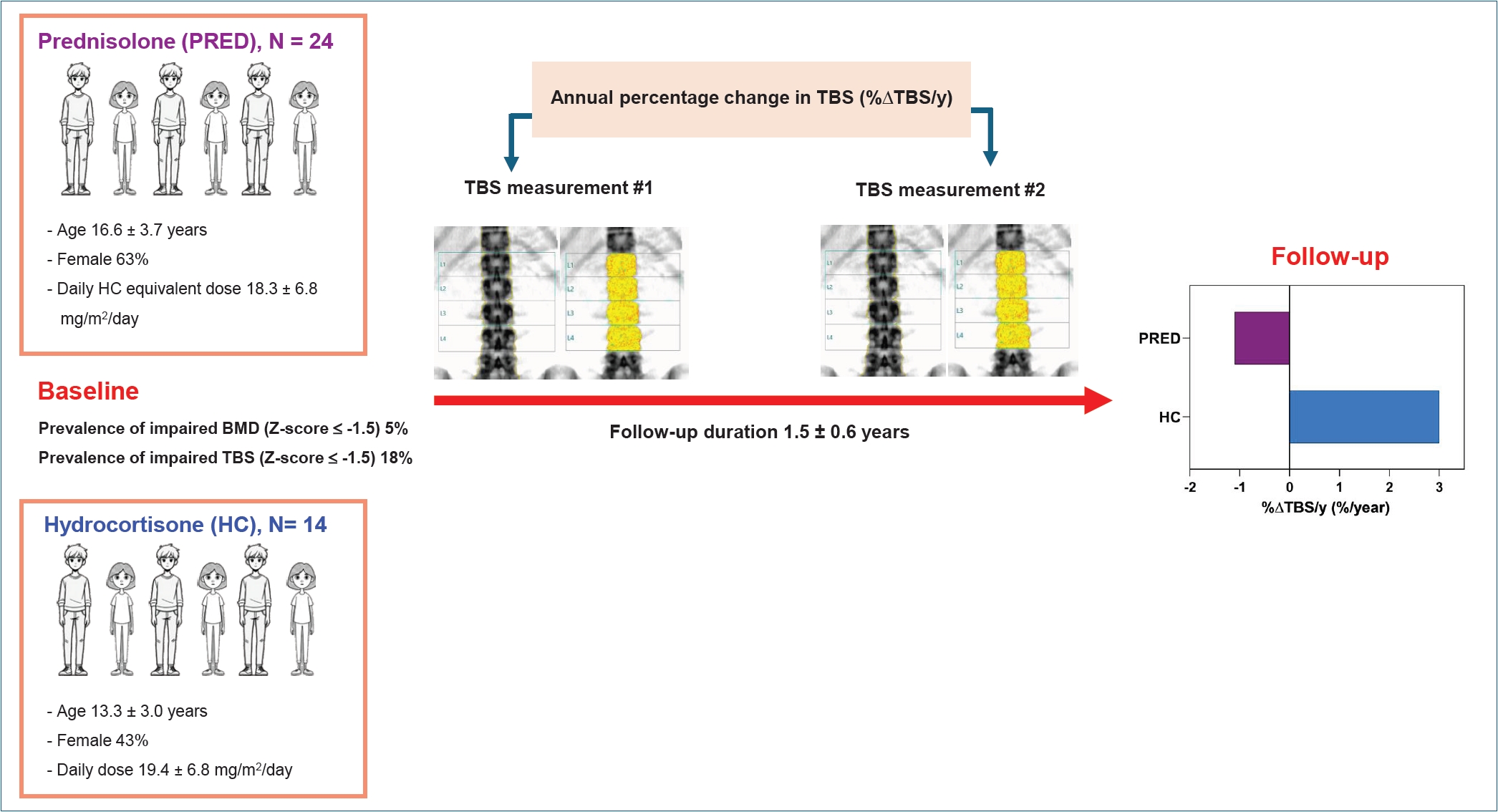
Question: What is the prevalence of an impaired trabecular bone score (TBS), a measure of bone microarchitecture, in adolescents with 21-hydroxylase deficiency (21OHD)? Do prednisolone and hydrocortisone affect TBS differently in this patient population?
Finding: Impaired TBS was observed in 18% of participants. Prednisolone use negatively impacted TBS change.
Meaning: Impaired TBS is prevalent among adolescents with 21OHD. Prednisolone impairs trabecular bone microarchitecture development.
- Review Article
- Adolescence Medicine
- Diet-related behaviors affecting health and substance use among children and adolescents
- Ji-Hyun Seo, Sochung Chung
- Clin Exp Pediatr. 2024;67(12):664-671. Published online October 31, 2024
-
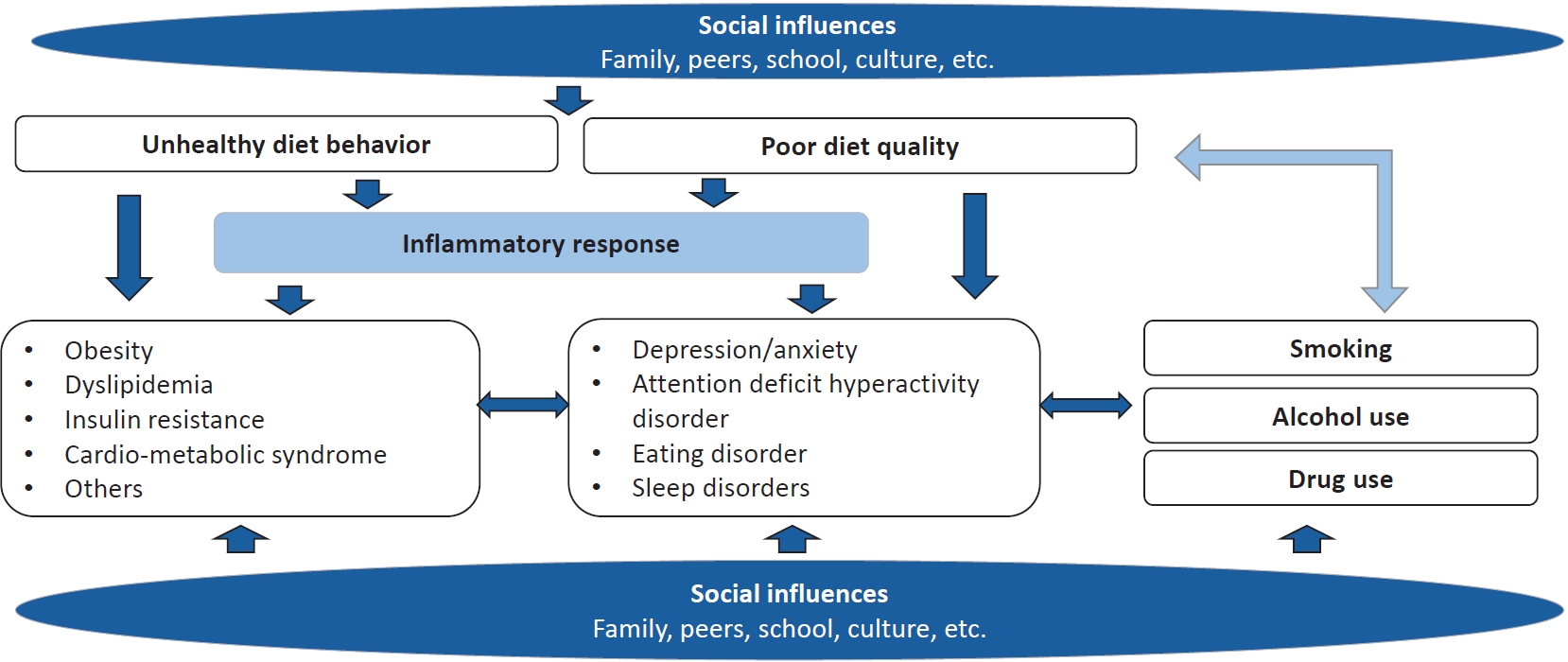
· Diet behaviors in children and adolescents are influenced by environmental and sociocultural factors.
· Unhealthy diet behaviors and poor diet quality are the main contributing factors to noncommunicable diseases and mental health problems during childhood and adolescence.
· Smoking and alcohol drinking in children and adolescents may be associated with unhealthy diet behavior or poor diet quality.
- Original Article
- Nutrition
- Energy drink consumption among Korean adolescents: prevalence and associated factors
- Jee-Seon Shim, Jeong Mi Lee
- Clin Exp Pediatr. 2024;67(10):531-539. Published online September 24, 2024
-

Question: How prevalent is energy drink consumption among Korean adolescents and what are the associated factors?
Findings: The prevalence of energy drink consumption among Korean adolescents increased from 3.2% in 2014 to 12.2% in 2019. Energy drink consumption varies according to sociode-mographic and individual factors.
Meaning: Policies and educational strategies are needed to reduce energy drink consumption in adolescents.
- Cardiology
- Comparative analysis of adolescent hypertension definitions for predicting early adulthood carotid artery intima-media thickness: Tehran lipid and glucose study
- Maryam Barzin, Shirin Yaghoobpoor, Maryam Mahdavi, Behnaz Abiri, Majid Valizadeh, Fereidoun Azizi, Pooneh Dehghan, Farhad Hosseinpanah
- Clin Exp Pediatr. 2024;67(12):694-703. Published online September 12, 2024
-
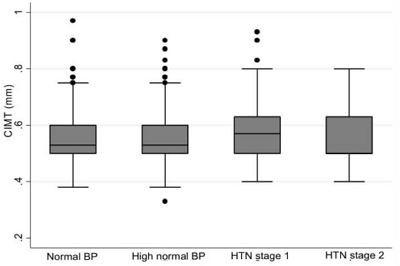
Question: What is the prevalence of HTN among adolescents enrolled in the TLGS according to 3 different accepted definitions (4th report, ESH, and AAP-CPG). Also, what is the ability of each of these definitions in predicting early adulthood CIMT, as a surrogate for cardiovascular disease events?
Finding: The highest and lowest prevalence of stage 1 HTN was observed with the AAP-CPG (17.7%) and ESH (8.8%), respectively. Similarly, the highest and lowest prevalence of stage 2 HTN was noted with the AAP-CPG (1.5%) and ESH (0.8%), respectively. The highest to lowest predictive abilities belonged to the 4th report, ESH, and AAP-CPG, respectively.
Meaning: Among the various definitions of pediatric HTN, the 4th report offered the best ability to predict a high CIMT during early adulthood, followed by the ESH and AAP-CPG.
- General Pediatrics
- Role of proper postnatal care in continued exclusive breastfeeding among young Indonesian mothers
- Wahyu Triadmajani, Shinta Prawitasari, Abdul Wahab
- Clin Exp Pediatr. 2024;67(12):686-693. Published online September 12, 2024
-
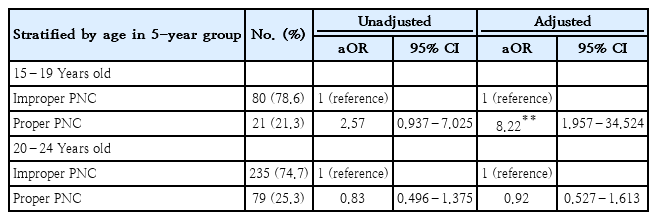
Question: Is proper postnatal care (PNC) associated with exclusive breastfeeding (EBF) practice among young Indonesian mothers?
Finding: Proper PNC elevates the likelihood of EBF among Indonesian adolescent mothers aged 15–19 years.
Meaning: Breastfeeding services should be provided during the early postnatal period to support EBF practice among adolescent mothers. High-quality PNC is a tailored intervention for vulnerable populations.
- Review Article
- Pulmonology
- Evidence-based management guidelines for noncystic fibrosis bronchiectasis in children and adolescents
- Eun Lee, Kyunghoon Kim, You Hoon Jeon, In Suk Sol, Jong Deok Kim, Taek Ki Min, Yoon Ha Hwang, Hyun-Ju Cho, Dong In Suh, Hwan Soo Kim, Yoon Hee Kim, Sung-Il Woo, Yong Ju Lee, Sungsu Jung, Hyeon-Jong Yang, Gwang Cheon Jang
- Clin Exp Pediatr. 2024;67(9):418-426. Published online January 23, 2024
-

· We suggest offering long-term macrolides to children with noncystic fibrosis bronchiectasis with frequent exacerbations (conditional recommendation, moderate quality of evidence).
· We do not recommend the routine use of mucolytic agents, inhaled corticosteroids, or nonsteroidal anti-inflammatory drugs to prevent exacerbation of bronchiectasis in children (inconclusive, very low quality of evidence).
· We recommend the use of nebulized hypertonic saline to prevent exacerbations and improve the lung function of children with noncystic fibrosis bronchiectasis (weak recommendation, moderate quality of evidence).
- Nutrition
- Macronutrients modified dietary intervention in the management of overweight/obese children and adolescents: a systematic review
- Jihyun Park, Oh Yoen Kim
- Clin Exp Pediatr. 2024;67(4):191-200. Published online July 11, 2023
-
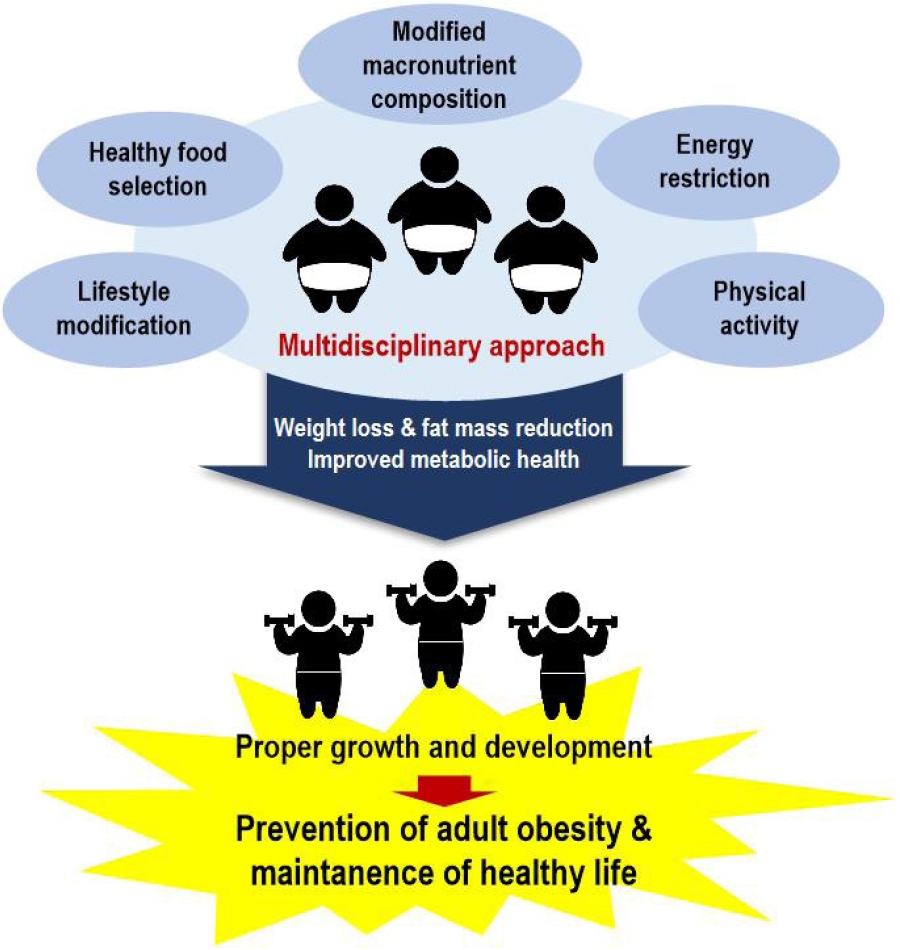
· Dietary macronutrient modifications affect the body composition of and metabolic markers in children and adolescents.
· Hypocaloric diets, regardless of macronutrient composition, are reportedly effective for weight loss in obese children.
· Future interventional studies with meta-analyses that include Korean children and adolescents are needed to provide basic information applicable to this population.
- Dietary intake and nutritional status of Korean children and adolescents: a review of national survey data
- Minji Kang, So Yoon Choi, Minyoung Jung
- Clin Exp Pediatr. 2021;64(9):443-458. Published online December 28, 2020
-
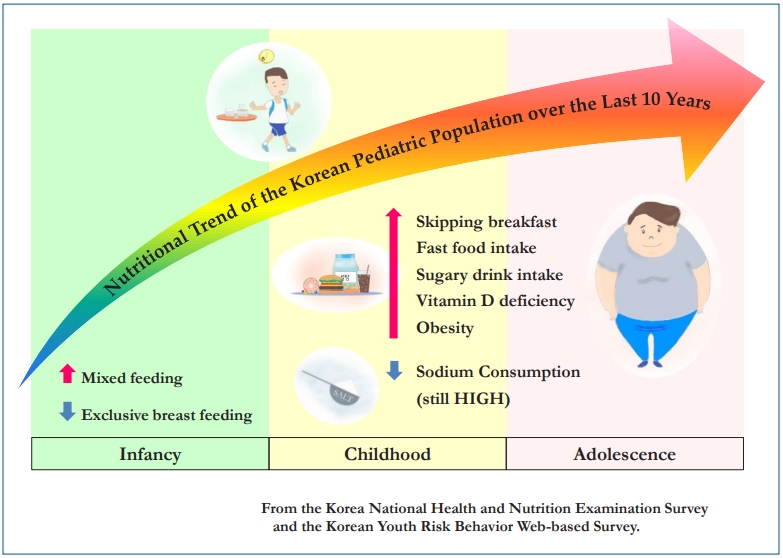
In Korea, several national cross-sectional surveys monitor the diet, nutritional status, and health status of children. This continual dedicated national surveillance system contributes to the identification of nutritional and health issues, establishment of public health policies, and development of nutrition recommendations. This paper provides recent information about the Korea National Health and Nutrition Examination Survey and the Korean Youth Risk...
- Original Article
- Cardiology
- Radiofrequency catheter ablation of atrioventricular nodal reentry tachycardia in children and adolescents: a single center experience
- Myung Chul Hyun
- Clin Exp Pediatr. 2017;60(12):390-394. Published online December 22, 2017
-
Purpose Atrioventricular nodal reentry tachycardia (AVNRT) is less common in pediatric patients than in adult patients. Thus, data for pediatric AVNRT patients are insufficient. Hence, we aimed to analyze the patient characteristics, treatment, and any recurrences in pediatric AVNRT patients.
Methods We reviewed the records of 50 pediatric AVNRT patients who had undergone radiofrequency catheter ablation (RFCA) between January 1998 and December 2016...
- Review Article
- Haploidentical hematopoietic stem cell transplantation in children and adolescents with acquired severe aplastic anemia
- Ho Joon Im, Kyung-Nam Koh, Jong Jin Seo
- Clin Exp Pediatr. 2015;58(6):199-205. Published online June 22, 2015
-
Severe aplastic anemia (SAA) is a life-threatening disorder for which allogeneic hematopoietic stem cell transplantation (HSCT) is the current available curative treatment. HSCT from matched sibling donors (MSDs) is the preferred therapy for children with acquired SAA. For patients who lack MSDs, immunosuppressive therapy (IST) is widely accepted as a first-line treatment before considering HCT from an unrelated donor (URD)....
- Osteosarcoma in Korean children and adolescents
- Jun Ah Lee
- Clin Exp Pediatr. 2015;58(4):123-128. Published online April 22, 2015
-
Osteosarcoma is the most frequent primary bone tumor. Advances in combination chemotherapy and surgical technique have greatly improved the survival of patients with osteosarcoma. In Korea, improvements in osteosarcoma treatment have been made over the past two decades. The 5-year event-free survival rate of Korean children and adolescents with localized disease is 64.6%, comparable to that of American or European...
- Original Article
- Prevalence of restless legs syndrome and sleep problems in Korean children and adolescents with attention deficit hyperactivity disorder: a single institution study
- Soonhak Kwon, Youngsoo Sohn, Seong-Hoon Jeong, Un-Sun Chung, Hyeeun Seo
- Clin Exp Pediatr. 2014;57(7):317-322. Published online July 23, 2014
-
Purpose Attention deficit hyperactivity disorder (ADHD) is a common disorder in school-aged children. Patients with restless legs syndrome (RLS) often present with ADHD symptoms and vice versa. This study was the first to attempt to identify the prevalence of RLS and sleep problems in children with ADHD in Korea.
Methods Patients diagnosed with ADHD were asked to complete a sleep questionnaire. The sleep...
- The results of cardiopulmonary exercise test in healthy Korean children and adolescents: single center study
- Jun-Sook Lee, So-Ick Jang, Seong-Ho Kim, Sang-Yun Lee, Jae-Suk Baek, Woo-Sup Shim
- Clin Exp Pediatr. 2013;56(6):242-246. Published online June 21, 2013
-
Purpose The cardiopulmonary exercise test (CPET) is an important clinical tool for evaluating exercise capacity and is frequently used to evaluate chronic conditions including congenital heart disease. However, data on the normal CPET values for Korean children and adolescents are lacking. The aim of this study was to provide reference data for CPET variables in children and adolescents.
Methods From August 2006 to...
- Review Article
- Current health issues in Korean adolescents
- Chang Ho Hong
- Clin Exp Pediatr. 2011;54(10):395-400. Published online October 31, 2011
-
During the adolescent period, they experience rapid physical, emotional, cognitive developments while they establish their lifestyle and habitual routines that strongly influence adult health and life. Recent rapid economic growth in Korea, and the earlier onset of physical, sexual, and psychological maturation of adolescents, has resulted in changes in the health status of adolescents from many years ago. Risk-taking behaviors...
- Nutrition requirements in child and adolescent athletes
- Jae Ock Park
- Clin Exp Pediatr. 2009;52(12):1327-1336. Published online December 15, 2009
-
Increasing numbers of children and adolescents prefer undertaking physical exercise to overcome overweight or obesity. Children and adolescents are in the growth stage and require adequate nutrient supply. More calories and nutrients are required especially when they are engaged in physical exercise. Exercise is the only means to increase lean body mass and decrease body fat, but adequate nutrient supply... -
- Obesity in children and adolescents
- Jeong Wan Seo
- Clin Exp Pediatr. 2009;52(12):1311-1320. Published online December 15, 2009
-
Childhood obesity has rapidly increased in Korea during the past 20–30 years. Approximately 1 of 10 children and adolescents is obese. Appropriate prevention and intervention measures urgently need. Obesity prevention starts early in life, i.e., obesity prevention and education begins during the period of fetal development in utero. Behavioral changes are the most positively reflected during pregnancy. Infants should be... -
- Recent concepts on vitamin D in children and adolescents
- Hye Ran Yang, Jeong Wan Seo, Yong Joo Kim, Jae Young Kim, Eell Ryoo, Jae Geon Sim, Hye Won Yom, Ju Young Chang, Ji A Jung, Kwang Hae Choi
- Clin Exp Pediatr. 2009;52(10):1082-1089. Published online October 15, 2009
-
Vitamin D is an important fat-soluble vitamin that functions as a prohormone and affects bone mineralization and calcium homeostasis. Vitamin D deficiency causesboth musculoskeletal manifestations, including rickets, and extra-musculoskeletal symptoms. Because vitamin D is naturally present in only some foods, intake of daily foods cannot meet the dietary reference intake for vitamin D. Sunlight is the main source of vitamin... -
- Peritoneal dialysis in children and adolescents
- Il Soo Ha
- Clin Exp Pediatr. 2009;52(10):1069-1074. Published online October 15, 2009
-
Peritoneal dialysis is a preferred modality of replacement therapy in children and adolescents with end-stage renal disease waiting for kidney transplantation. Recent development of pediatric swan-neck catheters with cuffs, novel dialysis solutions, and cyclers for automated peritoneal dialysis enabled more flexible prescriptions of dialysis with less complication, and improved patients' activities as well as the dialysis adequacy. Principles and practical... -
- Original Article
- Effectiveness of head-up tilt test for the diagnosis of syncope in children and adolescents
- Ka-Young Yu, Ji-Hye Choi, Chun Ja Yoo, Kyoung Suk Rhee, Chan Uhng Joo
- Clin Exp Pediatr. 2009;52(7):798-803. Published online July 15, 2009
-
Purpose : We aimed to examine the effectiveness of the head-up tilt test (HUT) for the diagnosis of syncope or presyncope in children and adolescents. Methods : HUT results and clinical features of 160 children and adolescents with syncope or presyncope were studied from May 2003 through March 2008 at the Chonbuk National University Hospital. The children and adolescents were subjected... -
- Review Article
- Metabolic syndrome in children and adolescents
- Young Mi Hong
- Clin Exp Pediatr. 2009;52(7):737-744. Published online July 15, 2009
-
Metabolic syndrome (MS) in children and adolescents has become a global public health problem. MS among Korean children and adolescents has been increasing significantly over the past decade. This paper aims to provide the currently available information on the MS in children and adolescents. This review focuses on the definition, diagnostic criteria, epidemiology and pathophysiology which may be helpful for... -
- Original Article
- Angiotensinogen gene M235T polymorphism as a predictor of cardiovascular risk in hypertensive adolescents
- Joo Hyun Gil, Jung Ah Lee, Eun Young Park, Young Mi Hong
- Clin Exp Pediatr. 2009;52(1):36-43. Published online January 15, 2009
-
Purpose : The renin-angiotensin system (RAS) has been demonstrated to play a major role in regulating blood pressure. Therefore, components of the RAS are likely candidate genes that may predispose an individual to essential hypertension and cardiovascular complications. Among them, the M235T polymorphism of the angiotensinogen gene has been speculated to be associated with elevated circulating angiotensinogen concentrations and essential... -
- Prevalence and trends in obesity among Korean children and adolescents in 1997 and 2005
- Kyungwon Oh, Myoung Jin Jang, Na Yeoun Lee, Jin Soo Moon, Chong Guk Lee, Myung Hwan Yoo, Young Taek Kim
- Clin Exp Pediatr. 2008;51(9):950-955. Published online September 15, 2008
-
Purpose : The objective of this study was to provide current estimates of the prevalence and examine trends of overweight and obesity in children and adolescents. Methods : Height and weight measurements from 183,159 (112,974 in 1997, 70,185 in 2005) children and adolescents aged 2 to 18 years were obtained via the 1997 and 2005 National Growth Survey. Obesity among... -
- Leptin, adiponectin, interleukin-6 and tumor necrosis factor- in obese adolescents
- Joo Hyun Gil, Jung Ah Lee, Ji Young Kim, Young Mi Hong
- Clin Exp Pediatr. 2008;51(6):597-603. Published online June 15, 2008
-
Purpose : Obesity is associated with insulin resistance. Insulin resistance and the presence of pro-inflammatory mediators are thought to cause a state of vascular endothelial dysfunction, an abnormal lipid profile, hypertension, and vascular inflammation. These chronic inflammatory responses, which are characterized by abnormal cytokine production, lead to activation of a pro-inflammatory signaling pathway. Leptin is an important mediator of inflammatory... -
- Review Article
- Epidemiologic characteristics of type 1 diabetes in children aged 14 years or under in Korea, 1985-2000
- Choong Ho Shin
- Clin Exp Pediatr. 2008;51(6):569-575. Published online June 15, 2008
-
Type 1 diabetes mellitus (T1DM) develops in genetically susceptible individuals as a result of progressive autoimmune destruction of beta cells. There is a large global variation in incidence among children aged 0-14 years. The incidence of T1DM in Korea is very low. The latest survey in Korea was conducted in 2001 by the Korean Society of Pediatrics to analyze ... -
- Epidemiology of the metabolic syndrome among Korean children and adolescents
- Mi Jung Park
- Clin Exp Pediatr. 2008;51(6):564-568. Published online June 15, 2008
-
The prevalence of obesity in Korean children is estimated to be around 10%, and has increased significantly over the past 20 years. Metabolic syndrome, which includes central obesity, glucose intolerance, insulin resistance, dyslipidemia, and hypertension, is a well documented risk factor for cardiovascular diseases, but there is no general consensus concerning its definition for children. In this study, ablut 30-40%... -
- Case Report
- Three cases of pulmonary and/or intestinal tuberculosis in adolescents
- Jung Hye Byeon, Yoon Lee, Jin Chul Lee, Young Yoo, Kee Hyoung Lee, Kwang Chul Lee, Ji Tae Choung, Soo Youn Ham, Chul Whan Kim
- Clin Exp Pediatr. 2007;50(11):1134-1138. Published online November 15, 2007
-
Since the tuberculosis (TB) in adolescents has unique clinical characteristics, special attention should be paid to this age group. Adolescents are more susceptible to developing TB disease and more likely to have cavitary pulmonary disease. Also, adolescent patients with TB more frequently present with extrapulmonary disease. We report three adolescents with active pulmonary and/or intestinal TB: one had pulmonary and... -
- Review Article
- Report about the health status of Korean adolescents - A comprehensive overview of the Korean adolescent health through demographics -
- Hea Kyoung Lee
- Clin Exp Pediatr. 2006;49(12):1267-1274. Published online December 15, 2006
-
-
- Original Article
- Pulse wave velocity and ankle brachial index in adolescents with essential hypertension
- Sun Young Joo, Ki Young Cho, Su Jin Cho, Young Mi Hong
- Clin Exp Pediatr. 2006;49(7):769-776. Published online July 15, 2006
-
Purpose : Pulse wave velocity(PWV) and ankle brachial index(ABI) are not only noninvasive methods used to assess arterial stiffness in adults, but also useful, simple ways to estimate the severity of hypertension, end stage renal disease and atherosclerosis in adults. But there are few studies on PWV and ABI in adolescents and children. In this study, hypertensive adolescents were compared... -
- Review Article
- Headaches in children and adolescents : diagnosis and treatment
- So Hee Eun, Baik-Lin Eun
- Clin Exp Pediatr. 2006;49(4):354-363. Published online April 15, 2006
-
Headaches are common in children and become more common and increase in frequency during adolescence. There are various causes of headaches. The majority of cases are considered as primary and include migraine and tension headaches. The rational evaluation of headache begins with careful history. Migraine is genetically determined recurrent pain syndrome accompanied by neurological and gastrointestinal features, involving interaction of... -
- Original Article
- Different Clinical Courses of Henoch-Sch nlein Purpura in Children, Adolescents and Adults
- Joo Hee Hong, Hyung Joon Na, Mee Kyung Namgoong, Seung Ok Choi, Byng Geun Han, Soon Hee Jung, Hwang Min Kim
- Clin Exp Pediatr. 2005;48(11):1244-1251. Published online November 15, 2005
-
Purpose : Henoch-Sch nlein purpura(HSP) is the most common and benign systemic vasculitis in children. Few reports have focused on worse outcomes of HSP in adults. The age of onset is suggested as a main risk factor. We assessed the characteristics of adolescent-onset HSP. Methods : We retrospectively analyzed 205 cases presented from Aug. 1993 to Oct. 2003. Patients were classified... -
-

-
-
6.02024CiteScore98th percentilePowered by
-
Impact Factor3.6
-
- TOPICS
- ARTICLE CATEGORY
- Editorial Office
-
Korean Pediatric Society
#1606 Seocho World Officetel, 19 Seoun-ro, Seocho-ku, Seoul 06732, Korea
Tel: +82-2-3473-7306 Fax: +82-2-3473-7307 E-mail: office@e-cep.org
Clinical and Experimental Pediatrics is an open access journal. All articles are distributed under the terms of the Creative Commons Attribution NonCommercial License (http://creativecommons.org/licenses/by-nc/4.0/)
Copyright © 2025 by Korean Pediatric Society.











